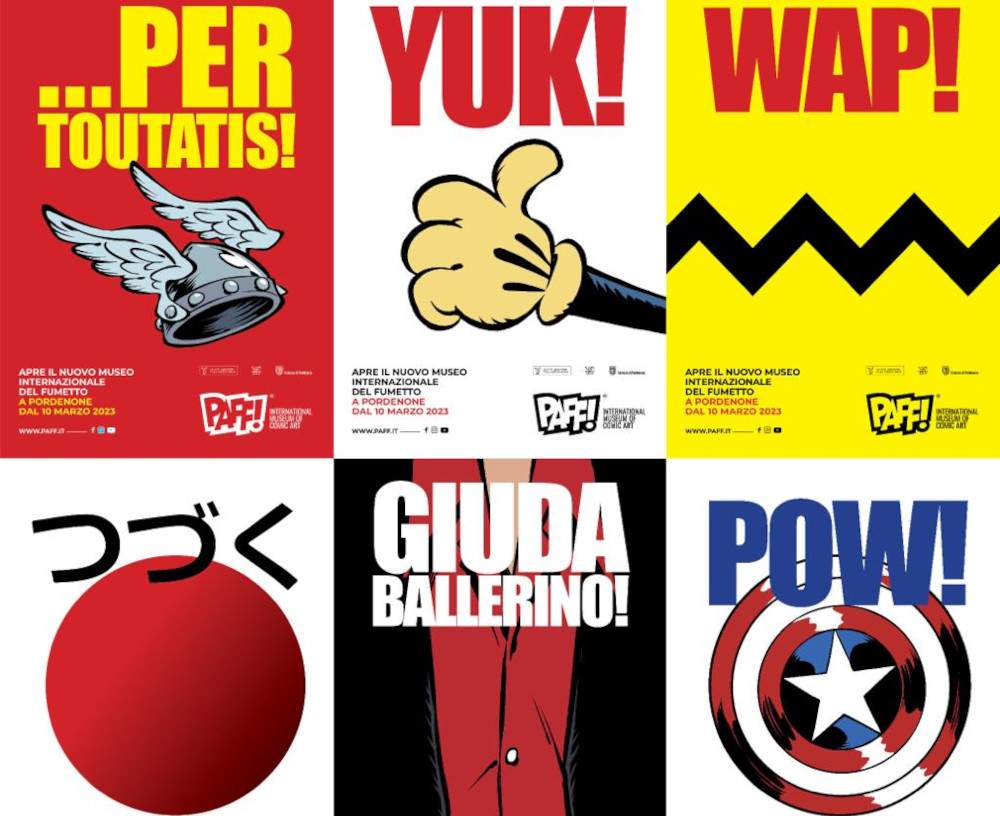PAFF! becomes International Museum of Comic Art, an international museum dedicated to the ninth art. Under the patronage of the Ministry of Culture, the Pordenone-based Palazzo Arti Fumetto Friuli will open itspermanent exhibition on March 10, 2023, enriched by a bibliomediatheque and by the end of the year by an archive with climate-controlled storage. The permanent exhibition, the curatorship of which has been entrusted by artistic director Giulio De Vita to Luca Raffaelli, an expert and historian of comics, intends to offer the public through a multimedia and interactive set-up the opportunity to admire about two hundred original plates by the most famous cartoonists of all time and more than five hundred sketches, script sheets, historical and rare publications, stage costumes used in films based on comics, set designs and films from all over the world through purchases, loans and donations.
Placed within the 2,200 square meters of exhibition space, the permanent collection will span one of the museum’s floors in nine different sections. The collection includes original plates by such masters and cartoonists as Carl Barks, Milton Caniff, Giorgio Cavazzano, Will Eisner, Floyd Gottfredson, Chester Gould, Benito Jacovitti, Magnus, Milo Manara, George McManus, Andrea Pazienza, Hugo Pratt, Alex Raymond, Charles M. Schulz, and Art Spiegelman. A sculpture by Ivan Tranquilli will also be on display, while for the museum Davide Toffolo has created the introductory panel on proto-comics, i.e., those illustrated stories (which adorned the Trajan Column or were published as drawings in nineteenth-century periodicals) that anticipated the birth of the comics industry and success.
Luca Raffaelli has given an original key to the exhibition’s narrative: that of the different formats by which comics, in their more than one hundred years of existence, have been read and loved around the world. In America, first the Sunday boards in the color supplements of U.S. newspapers were born, then the strips and comic books. In Italy we find instead the newspaper format (that of the first Corriere dei Piccoli) and the Tex strips, later brought to success by the format that bears his name; in France the volumes called albùm in Japan the tankobons, booklets where successful manga are published.
PAFF! thus defines itself as the only museum in the world dedicated to comics that places the focus on comparing original plates with reproductions, newspapers, albums, and books in which comics are published.
The declinations in which some plates have been published are highlighted in this way, showing the interactions that comics have had with other disciplines (film, painting, fashion, design, avant-garde, theater, literature) and fields (educational and entertainment). Most comics are born for a specific publishing purpose, dictating the space and timing of storytelling. Then history and success can change everything: an example is the Sunday board of Flash Gordon, large and in color, scaled down to a black-and-white pocket format. Or L’eternauta, a science fiction comic born in the Argentine horizontal format in the 1950s that became an Italian success in the vertical format of Lanciostory twenty years later. Or Spiegelman’s Maus, which began as an insert in an underground magazine that sold a few thousand copies and became one of the world’s best-known comic novels, winning a Pulitzer Prize in 1992.
In the permanent exhibition, the original board is shown throughout its editorial journey, emphasizing the relationship between comics and the communication industry, which has allowed different audiences in terms of culture, age and background to open a new look at this art also in dialogue with other artistic disciplines and their languages.
Finally, the multimedia component of the museum is particularly rich and well cared for, including 56 touchscreen displays, wi-fi connection with dedicated server for the interactive monitors, neckbands and tablets of the latest generation to enable visitors to have a unique interactive experience on comic arts.
By the end of 2023, the International Museum of Comic Art will also be enriched with an archive with climate-controlled storage for the preservation of the boards, drawings and publications that are part of the museum collection. The repository will feature an energy-efficient precision plant to maintain the rooms at a constant temperature of 18 degrees and a relative humidity of no more than 45 percent.
 |
| PAFF becomes international museum dedicated to comics and opens its permanent collection |
Warning: the translation into English of the original Italian article was created using automatic tools. We undertake to review all articles, but we do not guarantee the total absence of inaccuracies in the translation due to the program. You can find the original by clicking on the ITA button. If you find any mistake,please contact us.